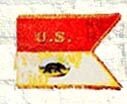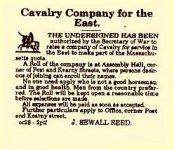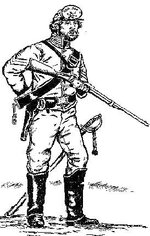pegleglooker
Bronze Member
- Jun 9, 2006
- 1,857
- 238
- Detector(s) used
- ace 250
- Primary Interest:
- All Treasure Hunting
This is the story of the California 100. Me who volunteered, bought thier own uniforms and paid for their own passage to the east..
Enjoy
PLL

2nd Regiment of Cavalry, Massachusetts Volunteers
(The California 100 and the California Cavalry Battalion)
"…all of a sudden it became a hand-to-hand affair. It was soon evident to (Captain J. Sewall) Reed that he was in for a whipping, and his men began breaking through the fences and into the field, but fighting all the while. His Californians, especially notoriously good fighters, were standing up to the rack like men, dealing out to us the best they had. They rallied at every call on them and went down with banners flying."
-John W. Munson, Commenting on the California 100 (Company A, Second Massachusetts Cavalry) from Reminiscences of a Mosby Guerrilla.
A Short History
by Larry Rogers
Many patriotic young men on the West coast had followed the war in the newspapers and were anxious for a chance to join in the fight. But they knew that if they joined a California unit they would be stationed in the West - fighting Indians, guarding wagon trains, or doing garrison duty. And so, in the late summer of 1862, a group of Californians, all, but one,
originally from the East Coast, contacted Governor Andrew of Massachusetts and proposed to raise one hundred volunteers to form a separate company in a cavalry regiment that was being raised in Massachusetts. The Governor readily agreed, with the condition that the Californians would provide their own uniforms and equipment. Officially they became Company "A" of the 2nd Massachusetts Cavalry, but they were more popularly known as the "California Hundred'.
The Californians used their enlistment bounty to pay for their passage and set off by sea from San Francisco, December 11, 1862. Their journey took them via the Isthmus of Panama and thence up the eastern seaboard to New York and on to Boston, arriving at Camp Meigs, Readville, Massachusetts (just outside Boston) on January 4, 1863. Alter spending
several weeks of basic training at Camp Meigs, the Company was transported to Fortress Monroe, Virginia, and placed on active duty at Gloucester Point on February 22, 1863.

This first contingent of Californians was so successful that it was soon followed by 400 more volunteers under similar terms. They arrived at Camp Meigs during March and April of 1863, and soon alter receiving their basic training were assigned to the defenses of Washington, D.C. They became Companies E, F, L and M of the 2nd Massachusetts Cavalry.
On July 27, 1863, Company A, the California Hundred, left Gloucester Point and on August 19, 1863, joined up with its fellow Californians at Centreville. There, they maintained a role in the defenses of the Capitol as well as countering the guerrilla raids of Mosby. They participated in the defenses of the Capitol during the siege by Jubal Early in July of 1864. In
August they were assigned to Sheridan's Army of the Shenandoah, and participated in the sweep of the Confederates from the Shenandoah Valley during the fall and winter of 1864. They fought with distinction in the battles of Winchester, Luray, Fisher's Hill and Cedar Creek. They were part of the long march from the Shenandoah to Petersburg in February and March of 1865 and later participated in the battles of Dinwiddie Court House, Five Forks and Sailors Creek. At wars end they were present at the surrender of Lee at Appomattox Court House. They took part in the Grand Review at Washington, D.C. on May 23, 1865.

They were mustered out of the U.S. service at Fairfax Court House, VA., July 20, 1865, and on August 3, 1865, having returned to Camp Meigs, the men were paid off and the regiment disbanded

Enjoy
PLL

2nd Regiment of Cavalry, Massachusetts Volunteers
(The California 100 and the California Cavalry Battalion)
"…all of a sudden it became a hand-to-hand affair. It was soon evident to (Captain J. Sewall) Reed that he was in for a whipping, and his men began breaking through the fences and into the field, but fighting all the while. His Californians, especially notoriously good fighters, were standing up to the rack like men, dealing out to us the best they had. They rallied at every call on them and went down with banners flying."
-John W. Munson, Commenting on the California 100 (Company A, Second Massachusetts Cavalry) from Reminiscences of a Mosby Guerrilla.
A Short History
by Larry Rogers
Many patriotic young men on the West coast had followed the war in the newspapers and were anxious for a chance to join in the fight. But they knew that if they joined a California unit they would be stationed in the West - fighting Indians, guarding wagon trains, or doing garrison duty. And so, in the late summer of 1862, a group of Californians, all, but one,
originally from the East Coast, contacted Governor Andrew of Massachusetts and proposed to raise one hundred volunteers to form a separate company in a cavalry regiment that was being raised in Massachusetts. The Governor readily agreed, with the condition that the Californians would provide their own uniforms and equipment. Officially they became Company "A" of the 2nd Massachusetts Cavalry, but they were more popularly known as the "California Hundred'.
The Californians used their enlistment bounty to pay for their passage and set off by sea from San Francisco, December 11, 1862. Their journey took them via the Isthmus of Panama and thence up the eastern seaboard to New York and on to Boston, arriving at Camp Meigs, Readville, Massachusetts (just outside Boston) on January 4, 1863. Alter spending
several weeks of basic training at Camp Meigs, the Company was transported to Fortress Monroe, Virginia, and placed on active duty at Gloucester Point on February 22, 1863.

This first contingent of Californians was so successful that it was soon followed by 400 more volunteers under similar terms. They arrived at Camp Meigs during March and April of 1863, and soon alter receiving their basic training were assigned to the defenses of Washington, D.C. They became Companies E, F, L and M of the 2nd Massachusetts Cavalry.
On July 27, 1863, Company A, the California Hundred, left Gloucester Point and on August 19, 1863, joined up with its fellow Californians at Centreville. There, they maintained a role in the defenses of the Capitol as well as countering the guerrilla raids of Mosby. They participated in the defenses of the Capitol during the siege by Jubal Early in July of 1864. In
August they were assigned to Sheridan's Army of the Shenandoah, and participated in the sweep of the Confederates from the Shenandoah Valley during the fall and winter of 1864. They fought with distinction in the battles of Winchester, Luray, Fisher's Hill and Cedar Creek. They were part of the long march from the Shenandoah to Petersburg in February and March of 1865 and later participated in the battles of Dinwiddie Court House, Five Forks and Sailors Creek. At wars end they were present at the surrender of Lee at Appomattox Court House. They took part in the Grand Review at Washington, D.C. on May 23, 1865.

They were mustered out of the U.S. service at Fairfax Court House, VA., July 20, 1865, and on August 3, 1865, having returned to Camp Meigs, the men were paid off and the regiment disbanded



